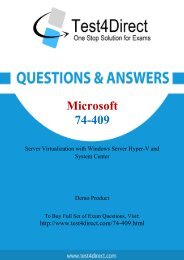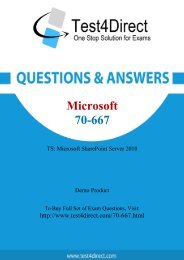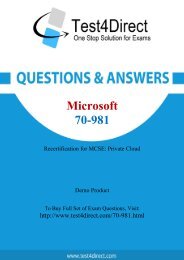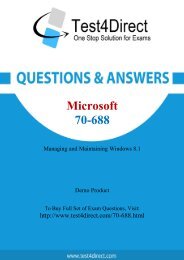70-646 Real BrainDumps
Test4Direct provides latest PDF questions of Microsoft 70-646 exam. You have an opportunity to pass the Microsoft 70-646 exam in one go. Test4Direct is most accurate source to prepare Microsoft 70-646 exam as your success will become site’s responsibility after purchasing 70-646 exam product. There are also lots of discounts and promotion offers that you can avail. Let’s try a free demo http://www.test4direct.com/70-646.html
Test4Direct provides latest PDF questions of Microsoft 70-646 exam. You have an opportunity to pass the Microsoft 70-646 exam in one go. Test4Direct is most accurate source to prepare Microsoft 70-646 exam as your success will become site’s responsibility after purchasing 70-646 exam product. There are also lots of discounts and promotion offers that you can avail. Let’s try a free demo http://www.test4direct.com/70-646.html
You also want an ePaper? Increase the reach of your titles
YUMPU automatically turns print PDFs into web optimized ePapers that Google loves.
A. In the branch office, implement Key Management Service (KMS), a DHCP server, and Windows<br />
Deployment Services (WDS).<br />
B. Use Multiple Activation Key (MAK) Independent Activation on the servers. In the main office,<br />
implement a DHCP server and Windows Deployment Services (WDS).<br />
C. In the main office, implement Windows Deployment Services (WDS). In the branch office,<br />
implement a DHCP server and implement the Key Management Service (KMS).<br />
D. Use Multiple Activation Key (MAK) Independent Activation on the servers. In the main office,<br />
implement a DHCP server. In the branch office, implement Windows Deployment Services (WDS).<br />
Question: 3<br />
Answer: A<br />
Explanation:<br />
The key here is that bandwidth from the branch to the main office is limited and there is no direct<br />
link to MS.<br />
WDS and Product Activation<br />
Although product activation does not need to occur during the actual installation process,<br />
administrators considering using WDS to automate deployment should also consider using volume<br />
activation to automate activation. Volume activation provides a simple centralized method that<br />
systems administrators can use for the activation of large numbers of deployed servers. Volume<br />
activation allows for two types of keys and three methods of activation. The key types are the<br />
Multiple Activation Key (MAK) and the Key Management Services (KMS) key.<br />
Multiple Activation Keys allow activation of a specific number of computers. Each successful<br />
activation depletes the activation pool. For example, a MAK key that has 100 activations allows for<br />
the activation of 100 computers. The Multiple Activation Key can use the MAK Proxy Activation and<br />
the MAK Independent Activation activation methods. MAK Proxy Activation uses a centralized<br />
activation request on behalf of multiple products using a single connection to Microsoft’s activation<br />
servers. MAK Independent Activation requires that each computer activates individually against<br />
Microsoft's activation servers.<br />
The Branch office has no internet connection, so MAK is not the solution.<br />
KMS requires at least 25 computers connecting before activation can occur, and activation must be<br />
renewed by reconnecting to the KMS server every 180 days.<br />
You can use KMS and MAK in conjunction with one another. The number of computers, how often<br />
they connect to the network, and whether there is Internet connectivity determines which solution<br />
you should deploy. You should deploy MAK if substantial numbers of computers do not connect to<br />
the network for more than 180 days. If there is no Internet connectivity and more than 25<br />
computers, you should deploy KMS. If there is no Internet connectivity and less than 25 computers,<br />
you will need to use MAK and activate each system over the telephone.<br />
Your network contains a Webbased Application that runs on Windows Server 2003. You plan to<br />
migrate the Webbased Application to Windows Server 2008 R2. You need to recommend a server<br />
configuration to support the Webbased Application. The server configuration must meet the<br />
following requirements:<br />
• Ensure that the Application is available to all users if a single server fails<br />
• Support the installation of .NET Applications<br />
• Minimize software costs<br />
What should you recommend?<br />
A. Install the Server Core installation of Windows Server 2008 R2 Standard on two servers. Configure<br />
the servers in a Network Load Balancing cluster.
















